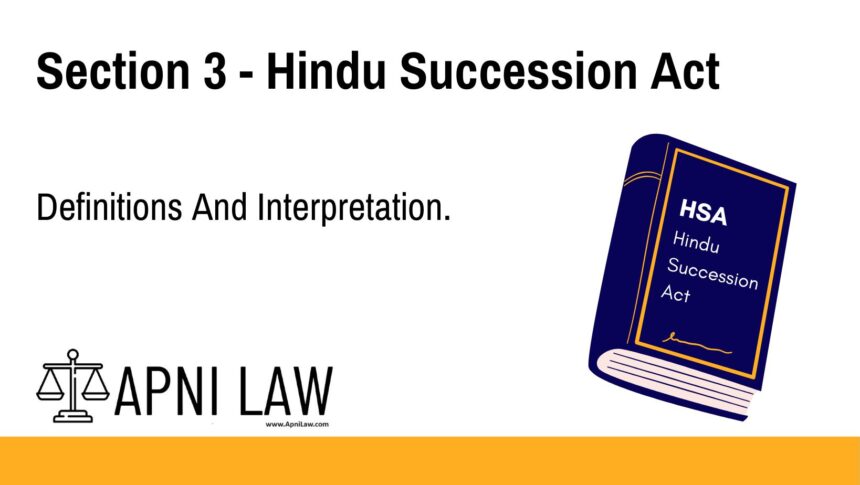Code: Section 3 of the Hindu Succession Act
1) In this Act, unless the
context otherwise requires,—
(a) “agnate”—one person is said to be an “agnate” of another
if the two are related by blood or adoption wholly through
males ;
(b) “cognate”—one person is said to be a cognate of another if
the two are related by blood or adoption but not wholly through
males ;
(c) the expressions “customs” and “usage” signify any rule which,
having been continuously and uniformly observed for a long
time, has obtained the force of law among Hindus in any
local area, tribe, community, group or family :
Provided that the rule is certain and not unreasonable or opposed
to public policy ; and
Provided further that in the case of a rule applicable only to a
family it has not been discontinued by the family ;
(d) “full blood”, “half blood” and “uterine blood”—
(i) two persons are said to be related to each other by
full blood when they are descended from a common
ancestor by the same wife, and by half blood when
they are descended from a common ancestor but by
different wives ;
(ii) two persons are said to be related to each other by uterine
blood when they are descended from a common ancestress
but by different husbands ;
Explanation:— In this clause “ancestor” includes the father and
“ancestress” the mother ;
(e) “heir” means any person, male or female, who is entitled to
succeed to the property of an intestate under this Act ;
(f) “intestate”—a person is deemed to die intestate in respect of
property of which he or she has not made a testamentary
disposition capable of taking effect ;
(g) “related” means related by legitimate kinship :
Provided that illegitimate children shall be deemed to be related
to their mother and to one another, and their legitimate descendants
shall be deemed to be related to them and to one another ; and any
word expressing relationship or denothing a relative shall be construed
accordingly.
(2) In this Act, unless the context otherwise requires, words
importing the masculine gender shall not be taken to include females.
Explanation of Section 3 of the Hindu Succession Act
Section 3 provides crucial definitions that form the foundation of the Hindu Succession Act. These terms determine who is eligible to inherit property and how inheritance is distributed among various communities and families. Understanding these definitions is essential for interpreting the Act’s provisions.
- Agnates are people connected solely through the male line, while Cognates are those connected through both male and female lines.
- Aliyasantana Law, Marumakkattayam Law, and Nambudri Law are regional legal systems that affect inheritance in specific communities.
- Terms like Full Blood, Half Blood, and Uterine Blood clarify relationships based on shared ancestors.
Together, these definitions help in understanding how the Act is applied across different familial and regional contexts.
Illustration
Example 1: Agnates
Ramesh and Suresh are brothers, both descendants of their father. Since they share the same father, they are considered agnates.
Example 2: Aliyasantana Law in Practice
In a community governed by Aliyasantana Law, inheritance passes through the maternal line. For example, a mother’s property would be inherited by her children rather than her brothers or paternal relatives.
Example 3: Illegitimate Children and Succession
Although illegitimate children generally have fewer rights than legitimate children, under the Hindu Succession Act, they are still considered related to their mother and siblings, allowing them to inherit accordingly.
Common Questions and Answers on Section 3 of the Hindu Succession Act
1. What does “agnate” mean?
- Answer: An agnate is someone related through the male line, either by blood or adoption. For example, brothers who share the same father are agnates.
2. Who is an “heir” under this law?
- Answer: An heir is any person, whether male or female, entitled to inherit property from someone who has died without a valid will.
3. What is “Aliyasantana Law”?
- Answer: Aliyasantana Law governs inheritance through the female line, particularly in South Indian communities.
4. How does “Nambudri Law” apply?
- Answer: Nambudri Law applies to communities like the Nambudris in Kerala, who follow specific inheritance rules based on regional legislation.
Conclusion
Section 3 of the Hindu Succession Act defines critical terms that help interpret the law’s provisions regarding inheritance. Understanding these definitions is crucial for navigating the rules around succession and determining who has the right to inherit property.








